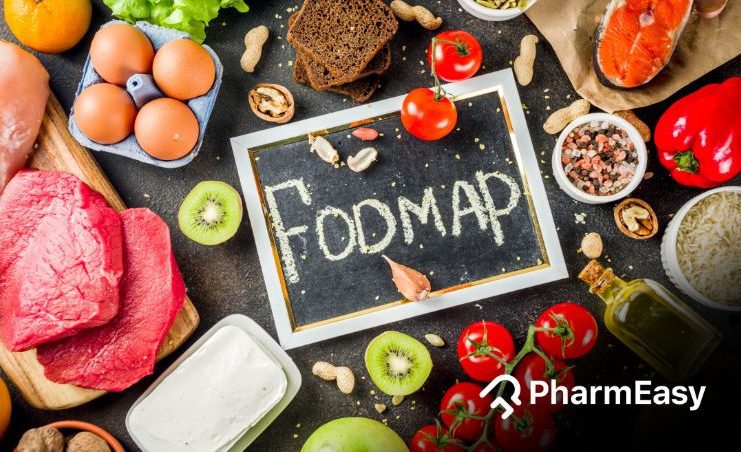Navigating Digestive Health: Understanding High FODMAP Foods
By Saksham Bhatia +2 more

Get more insightful and
helpful tips to
treat Diabetes for FREE



Download PharmEasy App




Register to Avail the Offer
Send OTPBy continuing, you agree with our Privacy Policy and Terms and Conditions
By Saksham Bhatia +2 more
FODMAP is an acronym that describes a specific class of carbohydrates known as fermentable short-chain carbohydrates. The full form of the acronym is Fermentable Oligosaccharides, Disaccharides, Monosaccharides and Polyols and it refers to a class of foods that are difficult for people to digest.

This article explains what are high FODMAP foods and whether you should cut them off your diet.
Table of Contents
Explaining the acronym FODMAP.
FODMAPs are fermentable short-chain carbohydrates. They are sugar molecules that are linked to each other in chains and are fermented by the bacteria in the gut. Molecules in the chains need to be broken down into single molecules that are absorbed by the small intestine. But foods that fall under the high FODMAPs group cannot be broken down easily and cannot be absorbed well. The small intestine draws in extra water to help move the FODMAPs through to the large intestine where the bacteria present in the colon end up fermenting them.
For your clearer understanding, below is a table illustrating some foods that are high in FODMAPs
| Fruits | Vegetables | Grains | Lactose-Containing Foods | Sweeteners | Legumes |
| Apples | Asparagus | Rye | Cream | Fructose | Butter beans |
| Apricots | Beets | Semolina | Custard | Honey | Baked beans |
| Grapefruit | Brussels sprouts | Wheat | Buttermilk | Maltitol | Kidney beans |
| Mango | Garlic | Farro | Milk | Isomalt | Lentils |
| Blackberries | Leeks | Barley | Yogurt | Mannitol | Soybeans |
| Pomegranates | Mushroom | Couscous | Soft cheese | Sorbitol | Chickpeas |
| Pears | Onions | Ice cream | Xylitol | Lima beans | |
| Peaches | Okra | Margarine | Molasses | ||
| Cauliflower | Honey | ||||
| Scallions | Corn syrup |
If you are someone who suffers from gastrointestinal disorders after consuming the foods high in FODMAPs mentioned above, you should concentrate on foods that are low in FODMAPs. These are provided below:
| Fruits | Vegetables | Sweeteners | Dairy & Alternatives | Nuts | Seeds | Grains | Proteins |
| Banana | Broccoli | Maple syrup | Coconut milk | Brazil nuts | Chia | Oats | Chicken |
| Avocado | Carrots | Powdered sugar | Almond milk | Peanuts | Caraway | Bulgur wheat | Fish |
| Lemon | Eggplant | Brown sugar | Rice milk | Walnuts | Pumpkin | Brown rice | Tofu |
| Kiwi | Green beans | Sugar (sucrose) | Lactose free dairy products | Macadamia nuts | Sesame | Quinoa | Lamb |
| Orange | Lettuce | Glucose | Almonds | Sunflower | Millets | Shellfish | |
| Olives | Parsley | Jaggery | Maize | ||||
| Papaya | Squash | ||||||
| Strawberry | Tomato | ||||||
| Grapes | Zucchini | ||||||
| Raspberry | Baby spinach |
Not everyone needs to avoid high FODMAP foods, it is for people who face abdominal discomfort after eating dal, chole, particular fruits and vegetables. Investing your time, energy and money into a low-FODMAP diet can be beneficial for your health, if you have already been diagnosed with certain gastrointestinal disorders. Creating your own FODMAP diet plan is not recommended as there are various risks associated with it. When you work with a dietitian, you know exactly well which high FODMAP foods to avoid and you get the assurance that you are getting proper balanced daily nutrition.
Also Read: Why Does Nicotine Make You Poop: Decoding Its Effects on Digestion
By following a low FODMAP diet, you can choose to eat what’s healthy and beneficial for your body. For people with chronic gastric troubles, the right dietary choices can help reduce many discomforts such as acid reflux, bloating, stomach pain and flatulence You can improve the quality of your life by managing the symptoms of IBS and also find yourself in a better position to be able to tackle symptoms of fatigue, stress and depression. Always consult a doctor and follow the changes advised.
Disclaimer: The information included on this site is for educational purposes only and is not intended to be a substitute for medical treatment by a healthcare professional. Because of unique individual needs, the reader should consult their physician to determine the appropriateness of the information for the reader’s situation.

Leave your comment...
Comments